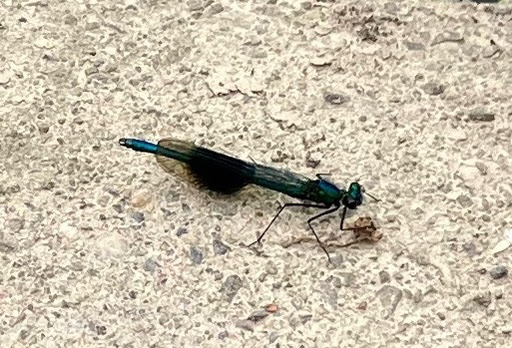Riverdance - Banded Demoiselles
29 June 2023

June. Mid-afternoon and the air thickens with a storm that is still two hours away. All along the riverbank, the Cow Parsley bows to the Himalayan Balsam which bows to the Vetch. The quiet hum of bees backs the narrative of birdsong; each creature telling their own small stories. I’ve seen a couple of ducks and the odd, hurried beetle, but apart from humans the most abundant species here today is the damselfly.
The Banded Demoiselle is a frequent sight on the River Severn in summer. They dart across each other, streaking iridescence over favourite haunts: the waterlilies, the reeds, the sunny bends. Their complex dance involves weaving, rising, falling, stopping, then starting all over again. Restless, they seem reluctant to leave the colony and yet determined to find their own space. Intermittently, they pause on the path to warm their wings and the hot stone glints with quartz. When I move, they move. When I stop, they stop. When I take a photo, I am disappointed – I cannot capture their colours.
A quick comparison to other, better images on the internet reveals something interesting. In photos, the band is simply a band, colour without texture. In real life the ‘band’ of the Banded Demoiselle looks furry, like an accessory borrowed from a mammal more than integral chitin of invertebrate wing. Known as a ‘fingerprint’, the metallic blue males wear the mark; the females are green with translucent wings and the intricate vein-structure is their only adornment.
The males are the dancers and their dance, as always, is about territory and mating. Slow-flowing rivers, ponds, lakes, and canals are their favoured habitats, and they search out lush vegetation where females can lay eggs. Injected into plant stems below the water’s surface, the eggs hatch quick enough, but the larvae spend two years lurking in the mud below. As adults, the demoiselles live only a few short weeks.
Two years ago, this cohort hatched into a slightly cooler climate. Two years ahead, their offspring will emerge onto a hotter planet. This year’s babies will never know their parents; each generation is independent to itself. Unlike humans, they have no one to learn from. Unlike us, they leave no footprints. Yet their species has been around since before the dinosaurs and their ‘fingerprints’ may long outlive us; flecking the riverbanks and dancing in the sun each summer, living bright, brilliant lives, before the rains begin.
